Annual Basketball Training Program for a 16-Year-Old Player
VerifiedAdded on 2022/09/01
|10
|2824
|21
Report
AI Summary
This report presents a detailed annual basketball training program designed for a 16-year-old basketball player named Mercy Yegon. It begins by outlining the physiological demands of basketball, emphasizing the need for both aerobic and anaerobic systems, and the importance of various physical skills like speed, agility, and muscular strength. The report then analyzes Mercy's current physiological status, training background, and performance metrics, including her strengths in ball handling, blocking, and rebounding. The core of the report focuses on the periodization of the annual training program, breaking it down into off-season, pre-season, and in-season phases. Each phase includes specific training recommendations for aerobic and strength conditioning, flexibility, speed, and agility. The report also discusses the rationale behind the training methods, emphasizing the importance of speed, agility, and injury prevention. Finally, it provides a microcycle example to illustrate a weekly training plan, ensuring a structured approach to player development and performance enhancement. This report is a comprehensive guide for coaches and players alike, aiming to optimize performance through structured training and conditioning.
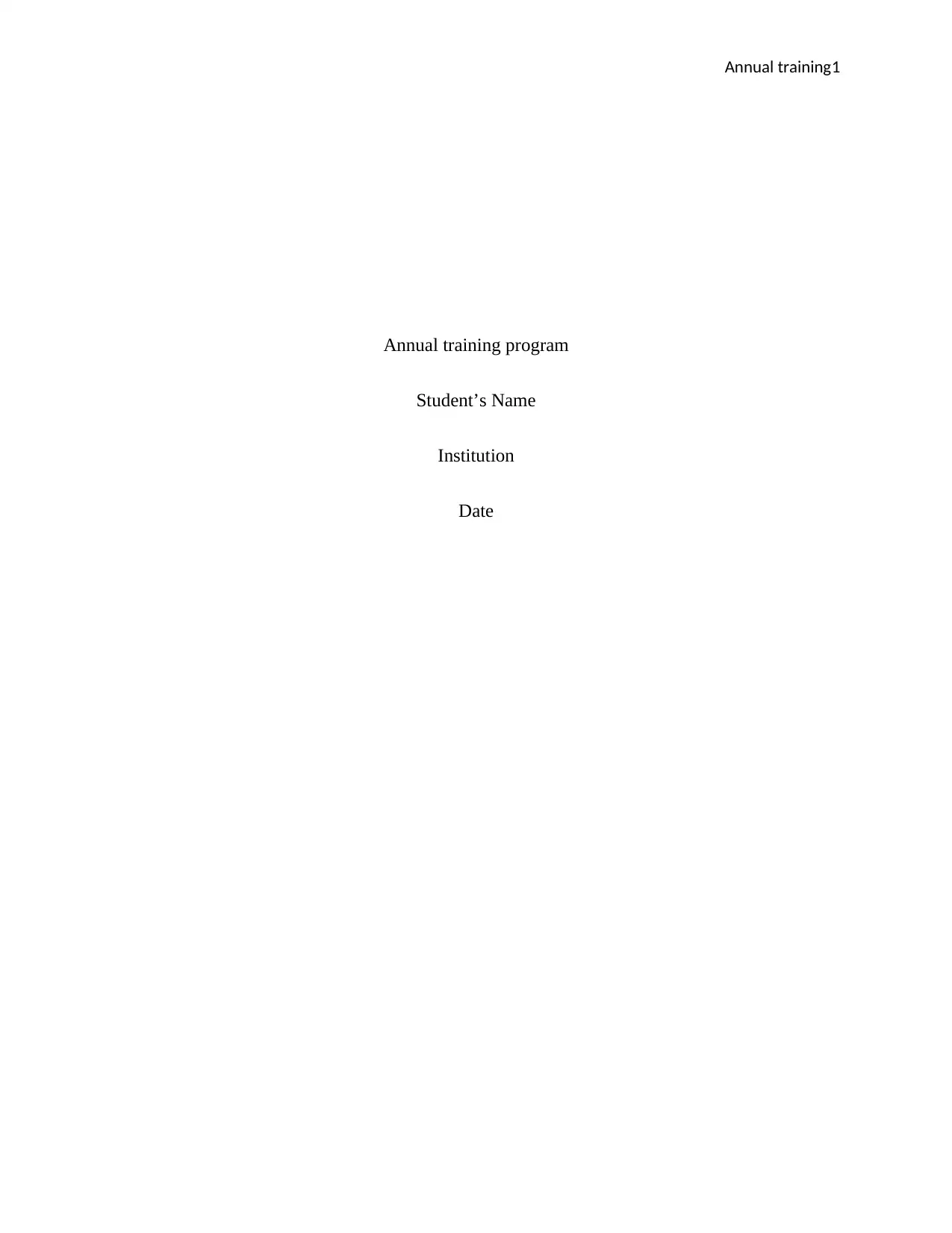
Annual training1
Annual training program
Student’s Name
Institution
Date
Annual training program
Student’s Name
Institution
Date
Paraphrase This Document
Need a fresh take? Get an instant paraphrase of this document with our AI Paraphraser
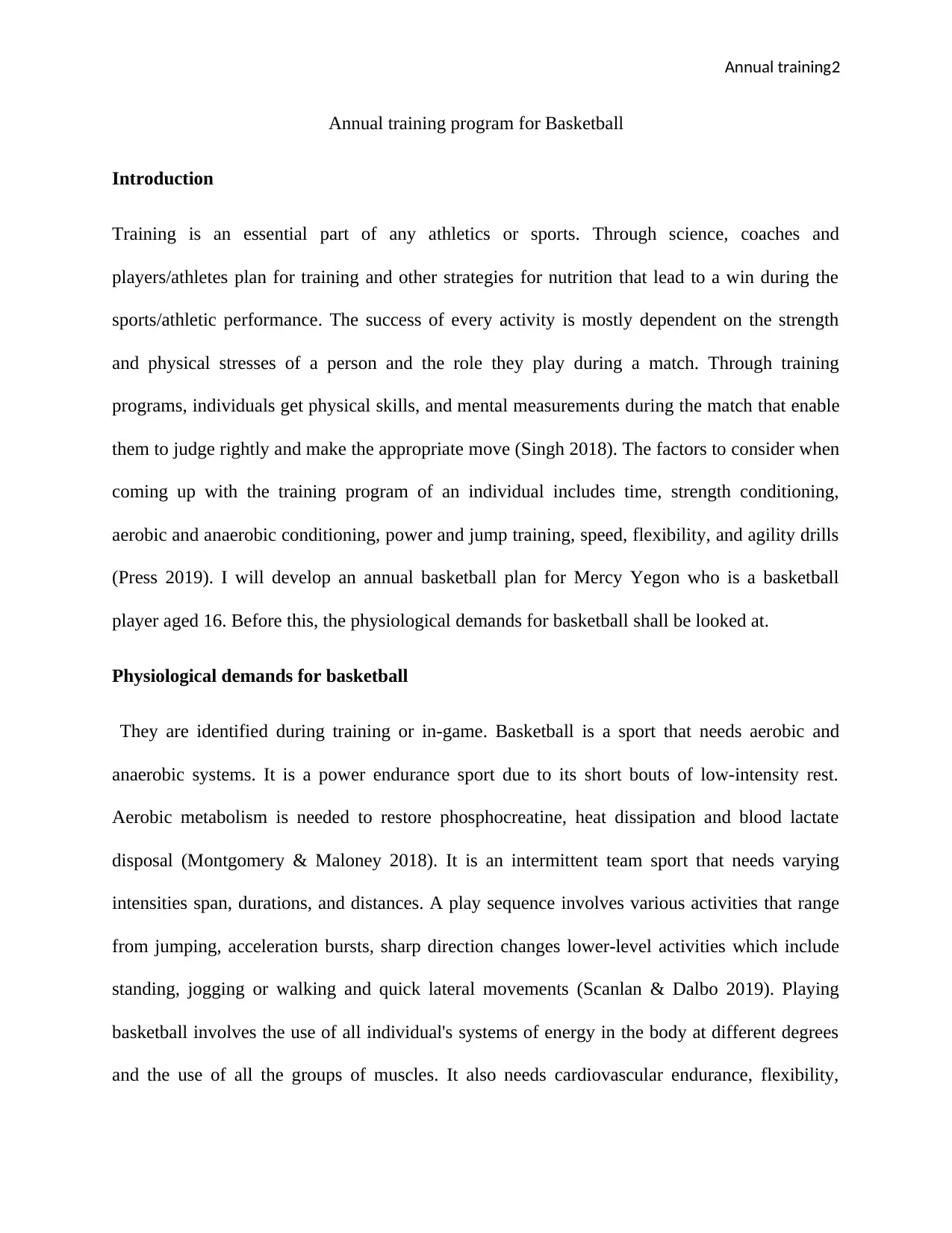
Annual training2
Annual training program for Basketball
Introduction
Training is an essential part of any athletics or sports. Through science, coaches and
players/athletes plan for training and other strategies for nutrition that lead to a win during the
sports/athletic performance. The success of every activity is mostly dependent on the strength
and physical stresses of a person and the role they play during a match. Through training
programs, individuals get physical skills, and mental measurements during the match that enable
them to judge rightly and make the appropriate move (Singh 2018). The factors to consider when
coming up with the training program of an individual includes time, strength conditioning,
aerobic and anaerobic conditioning, power and jump training, speed, flexibility, and agility drills
(Press 2019). I will develop an annual basketball plan for Mercy Yegon who is a basketball
player aged 16. Before this, the physiological demands for basketball shall be looked at.
Physiological demands for basketball
They are identified during training or in-game. Basketball is a sport that needs aerobic and
anaerobic systems. It is a power endurance sport due to its short bouts of low-intensity rest.
Aerobic metabolism is needed to restore phosphocreatine, heat dissipation and blood lactate
disposal (Montgomery & Maloney 2018). It is an intermittent team sport that needs varying
intensities span, durations, and distances. A play sequence involves various activities that range
from jumping, acceleration bursts, sharp direction changes lower-level activities which include
standing, jogging or walking and quick lateral movements (Scanlan & Dalbo 2019). Playing
basketball involves the use of all individual's systems of energy in the body at different degrees
and the use of all the groups of muscles. It also needs cardiovascular endurance, flexibility,
Annual training program for Basketball
Introduction
Training is an essential part of any athletics or sports. Through science, coaches and
players/athletes plan for training and other strategies for nutrition that lead to a win during the
sports/athletic performance. The success of every activity is mostly dependent on the strength
and physical stresses of a person and the role they play during a match. Through training
programs, individuals get physical skills, and mental measurements during the match that enable
them to judge rightly and make the appropriate move (Singh 2018). The factors to consider when
coming up with the training program of an individual includes time, strength conditioning,
aerobic and anaerobic conditioning, power and jump training, speed, flexibility, and agility drills
(Press 2019). I will develop an annual basketball plan for Mercy Yegon who is a basketball
player aged 16. Before this, the physiological demands for basketball shall be looked at.
Physiological demands for basketball
They are identified during training or in-game. Basketball is a sport that needs aerobic and
anaerobic systems. It is a power endurance sport due to its short bouts of low-intensity rest.
Aerobic metabolism is needed to restore phosphocreatine, heat dissipation and blood lactate
disposal (Montgomery & Maloney 2018). It is an intermittent team sport that needs varying
intensities span, durations, and distances. A play sequence involves various activities that range
from jumping, acceleration bursts, sharp direction changes lower-level activities which include
standing, jogging or walking and quick lateral movements (Scanlan & Dalbo 2019). Playing
basketball involves the use of all individual's systems of energy in the body at different degrees
and the use of all the groups of muscles. It also needs cardiovascular endurance, flexibility,
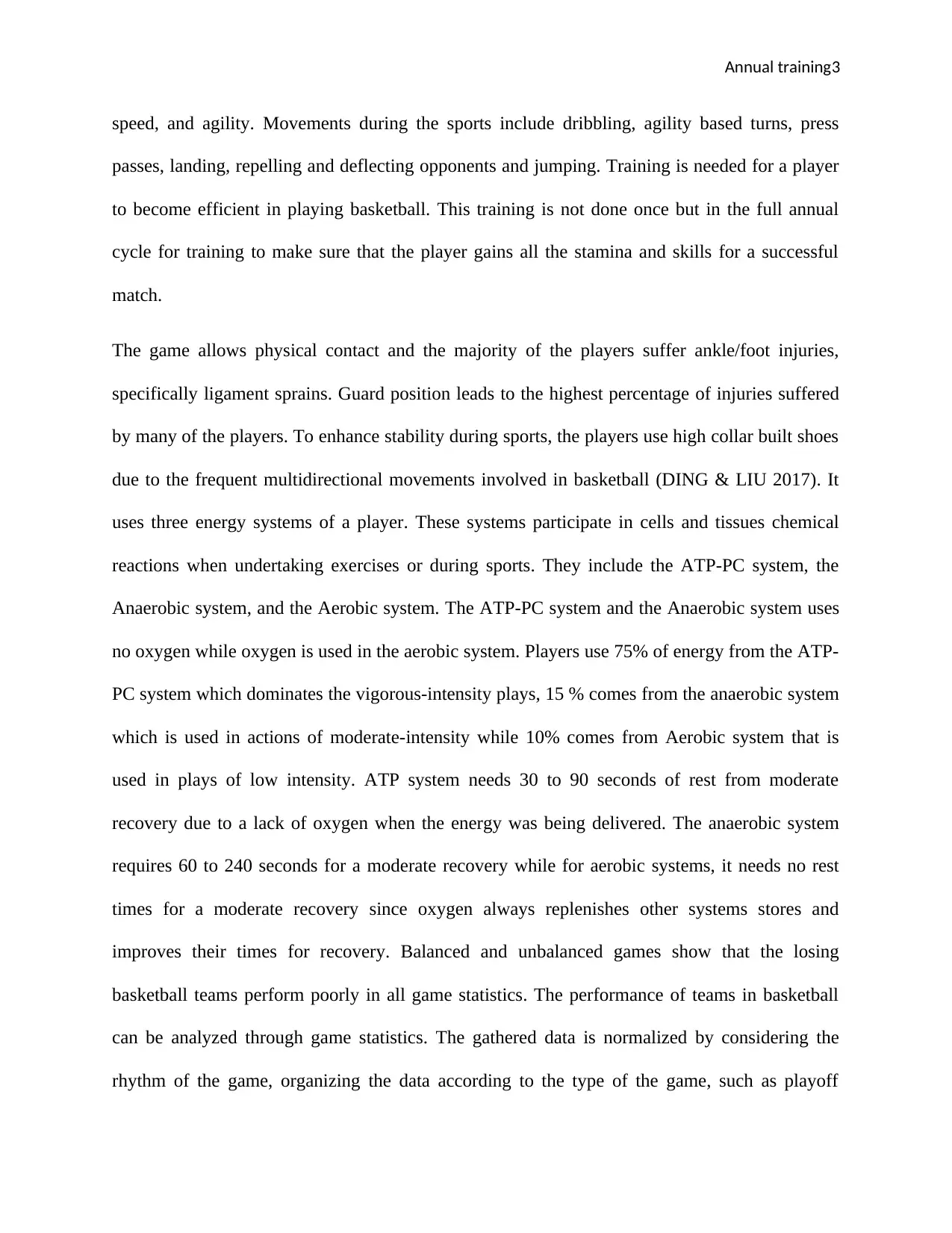
Annual training3
speed, and agility. Movements during the sports include dribbling, agility based turns, press
passes, landing, repelling and deflecting opponents and jumping. Training is needed for a player
to become efficient in playing basketball. This training is not done once but in the full annual
cycle for training to make sure that the player gains all the stamina and skills for a successful
match.
The game allows physical contact and the majority of the players suffer ankle/foot injuries,
specifically ligament sprains. Guard position leads to the highest percentage of injuries suffered
by many of the players. To enhance stability during sports, the players use high collar built shoes
due to the frequent multidirectional movements involved in basketball (DING & LIU 2017). It
uses three energy systems of a player. These systems participate in cells and tissues chemical
reactions when undertaking exercises or during sports. They include the ATP-PC system, the
Anaerobic system, and the Aerobic system. The ATP-PC system and the Anaerobic system uses
no oxygen while oxygen is used in the aerobic system. Players use 75% of energy from the ATP-
PC system which dominates the vigorous-intensity plays, 15 % comes from the anaerobic system
which is used in actions of moderate-intensity while 10% comes from Aerobic system that is
used in plays of low intensity. ATP system needs 30 to 90 seconds of rest from moderate
recovery due to a lack of oxygen when the energy was being delivered. The anaerobic system
requires 60 to 240 seconds for a moderate recovery while for aerobic systems, it needs no rest
times for a moderate recovery since oxygen always replenishes other systems stores and
improves their times for recovery. Balanced and unbalanced games show that the losing
basketball teams perform poorly in all game statistics. The performance of teams in basketball
can be analyzed through game statistics. The gathered data is normalized by considering the
rhythm of the game, organizing the data according to the type of the game, such as playoff
speed, and agility. Movements during the sports include dribbling, agility based turns, press
passes, landing, repelling and deflecting opponents and jumping. Training is needed for a player
to become efficient in playing basketball. This training is not done once but in the full annual
cycle for training to make sure that the player gains all the stamina and skills for a successful
match.
The game allows physical contact and the majority of the players suffer ankle/foot injuries,
specifically ligament sprains. Guard position leads to the highest percentage of injuries suffered
by many of the players. To enhance stability during sports, the players use high collar built shoes
due to the frequent multidirectional movements involved in basketball (DING & LIU 2017). It
uses three energy systems of a player. These systems participate in cells and tissues chemical
reactions when undertaking exercises or during sports. They include the ATP-PC system, the
Anaerobic system, and the Aerobic system. The ATP-PC system and the Anaerobic system uses
no oxygen while oxygen is used in the aerobic system. Players use 75% of energy from the ATP-
PC system which dominates the vigorous-intensity plays, 15 % comes from the anaerobic system
which is used in actions of moderate-intensity while 10% comes from Aerobic system that is
used in plays of low intensity. ATP system needs 30 to 90 seconds of rest from moderate
recovery due to a lack of oxygen when the energy was being delivered. The anaerobic system
requires 60 to 240 seconds for a moderate recovery while for aerobic systems, it needs no rest
times for a moderate recovery since oxygen always replenishes other systems stores and
improves their times for recovery. Balanced and unbalanced games show that the losing
basketball teams perform poorly in all game statistics. The performance of teams in basketball
can be analyzed through game statistics. The gathered data is normalized by considering the
rhythm of the game, organizing the data according to the type of the game, such as playoff
⊘ This is a preview!⊘
Do you want full access?
Subscribe today to unlock all pages.

Trusted by 1+ million students worldwide
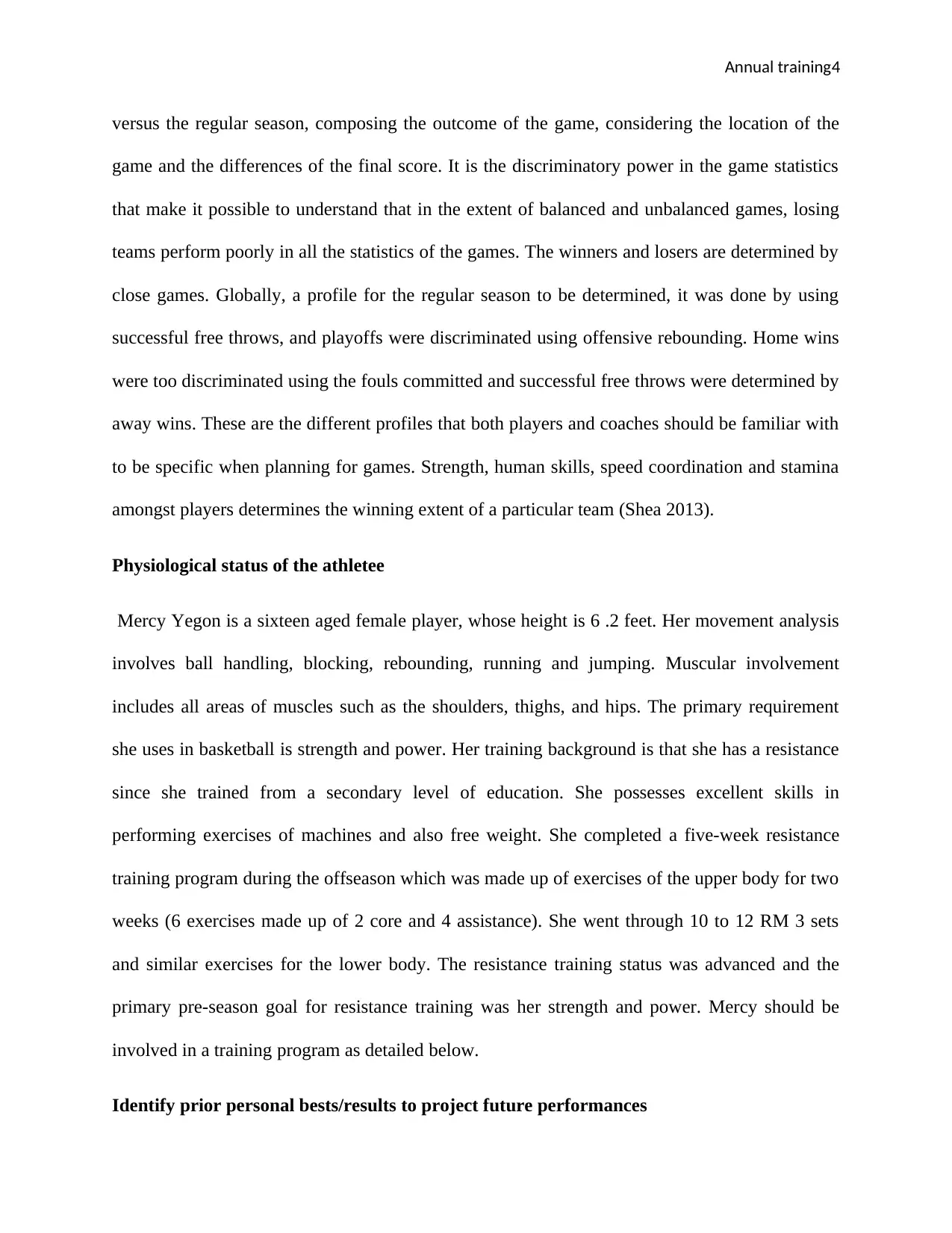
Annual training4
versus the regular season, composing the outcome of the game, considering the location of the
game and the differences of the final score. It is the discriminatory power in the game statistics
that make it possible to understand that in the extent of balanced and unbalanced games, losing
teams perform poorly in all the statistics of the games. The winners and losers are determined by
close games. Globally, a profile for the regular season to be determined, it was done by using
successful free throws, and playoffs were discriminated using offensive rebounding. Home wins
were too discriminated using the fouls committed and successful free throws were determined by
away wins. These are the different profiles that both players and coaches should be familiar with
to be specific when planning for games. Strength, human skills, speed coordination and stamina
amongst players determines the winning extent of a particular team (Shea 2013).
Physiological status of the athletee
Mercy Yegon is a sixteen aged female player, whose height is 6 .2 feet. Her movement analysis
involves ball handling, blocking, rebounding, running and jumping. Muscular involvement
includes all areas of muscles such as the shoulders, thighs, and hips. The primary requirement
she uses in basketball is strength and power. Her training background is that she has a resistance
since she trained from a secondary level of education. She possesses excellent skills in
performing exercises of machines and also free weight. She completed a five-week resistance
training program during the offseason which was made up of exercises of the upper body for two
weeks (6 exercises made up of 2 core and 4 assistance). She went through 10 to 12 RM 3 sets
and similar exercises for the lower body. The resistance training status was advanced and the
primary pre-season goal for resistance training was her strength and power. Mercy should be
involved in a training program as detailed below.
Identify prior personal bests/results to project future performances
versus the regular season, composing the outcome of the game, considering the location of the
game and the differences of the final score. It is the discriminatory power in the game statistics
that make it possible to understand that in the extent of balanced and unbalanced games, losing
teams perform poorly in all the statistics of the games. The winners and losers are determined by
close games. Globally, a profile for the regular season to be determined, it was done by using
successful free throws, and playoffs were discriminated using offensive rebounding. Home wins
were too discriminated using the fouls committed and successful free throws were determined by
away wins. These are the different profiles that both players and coaches should be familiar with
to be specific when planning for games. Strength, human skills, speed coordination and stamina
amongst players determines the winning extent of a particular team (Shea 2013).
Physiological status of the athletee
Mercy Yegon is a sixteen aged female player, whose height is 6 .2 feet. Her movement analysis
involves ball handling, blocking, rebounding, running and jumping. Muscular involvement
includes all areas of muscles such as the shoulders, thighs, and hips. The primary requirement
she uses in basketball is strength and power. Her training background is that she has a resistance
since she trained from a secondary level of education. She possesses excellent skills in
performing exercises of machines and also free weight. She completed a five-week resistance
training program during the offseason which was made up of exercises of the upper body for two
weeks (6 exercises made up of 2 core and 4 assistance). She went through 10 to 12 RM 3 sets
and similar exercises for the lower body. The resistance training status was advanced and the
primary pre-season goal for resistance training was her strength and power. Mercy should be
involved in a training program as detailed below.
Identify prior personal bests/results to project future performances
Paraphrase This Document
Need a fresh take? Get an instant paraphrase of this document with our AI Paraphraser
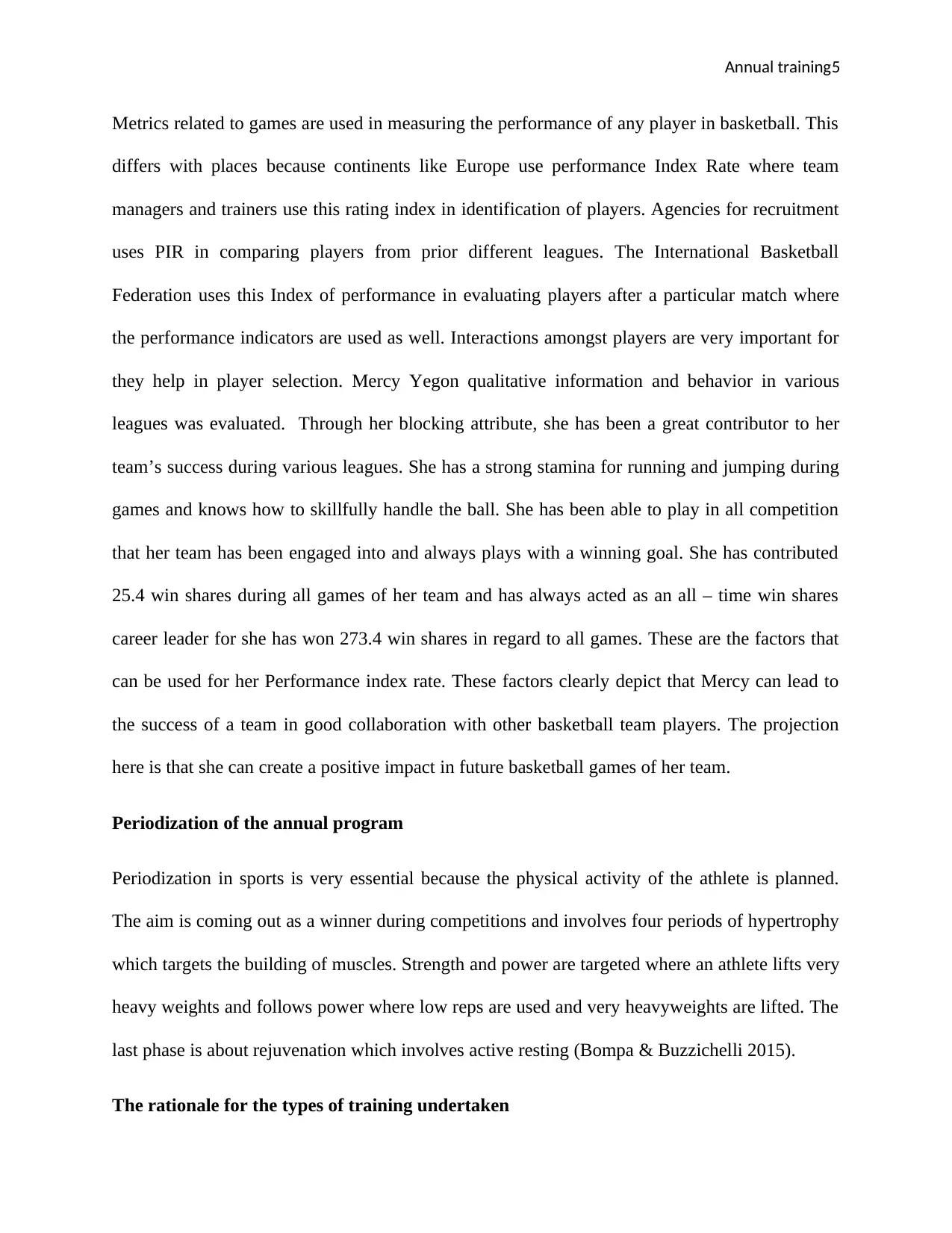
Annual training5
Metrics related to games are used in measuring the performance of any player in basketball. This
differs with places because continents like Europe use performance Index Rate where team
managers and trainers use this rating index in identification of players. Agencies for recruitment
uses PIR in comparing players from prior different leagues. The International Basketball
Federation uses this Index of performance in evaluating players after a particular match where
the performance indicators are used as well. Interactions amongst players are very important for
they help in player selection. Mercy Yegon qualitative information and behavior in various
leagues was evaluated. Through her blocking attribute, she has been a great contributor to her
team’s success during various leagues. She has a strong stamina for running and jumping during
games and knows how to skillfully handle the ball. She has been able to play in all competition
that her team has been engaged into and always plays with a winning goal. She has contributed
25.4 win shares during all games of her team and has always acted as an all – time win shares
career leader for she has won 273.4 win shares in regard to all games. These are the factors that
can be used for her Performance index rate. These factors clearly depict that Mercy can lead to
the success of a team in good collaboration with other basketball team players. The projection
here is that she can create a positive impact in future basketball games of her team.
Periodization of the annual program
Periodization in sports is very essential because the physical activity of the athlete is planned.
The aim is coming out as a winner during competitions and involves four periods of hypertrophy
which targets the building of muscles. Strength and power are targeted where an athlete lifts very
heavy weights and follows power where low reps are used and very heavyweights are lifted. The
last phase is about rejuvenation which involves active resting (Bompa & Buzzichelli 2015).
The rationale for the types of training undertaken
Metrics related to games are used in measuring the performance of any player in basketball. This
differs with places because continents like Europe use performance Index Rate where team
managers and trainers use this rating index in identification of players. Agencies for recruitment
uses PIR in comparing players from prior different leagues. The International Basketball
Federation uses this Index of performance in evaluating players after a particular match where
the performance indicators are used as well. Interactions amongst players are very important for
they help in player selection. Mercy Yegon qualitative information and behavior in various
leagues was evaluated. Through her blocking attribute, she has been a great contributor to her
team’s success during various leagues. She has a strong stamina for running and jumping during
games and knows how to skillfully handle the ball. She has been able to play in all competition
that her team has been engaged into and always plays with a winning goal. She has contributed
25.4 win shares during all games of her team and has always acted as an all – time win shares
career leader for she has won 273.4 win shares in regard to all games. These are the factors that
can be used for her Performance index rate. These factors clearly depict that Mercy can lead to
the success of a team in good collaboration with other basketball team players. The projection
here is that she can create a positive impact in future basketball games of her team.
Periodization of the annual program
Periodization in sports is very essential because the physical activity of the athlete is planned.
The aim is coming out as a winner during competitions and involves four periods of hypertrophy
which targets the building of muscles. Strength and power are targeted where an athlete lifts very
heavy weights and follows power where low reps are used and very heavyweights are lifted. The
last phase is about rejuvenation which involves active resting (Bompa & Buzzichelli 2015).
The rationale for the types of training undertaken
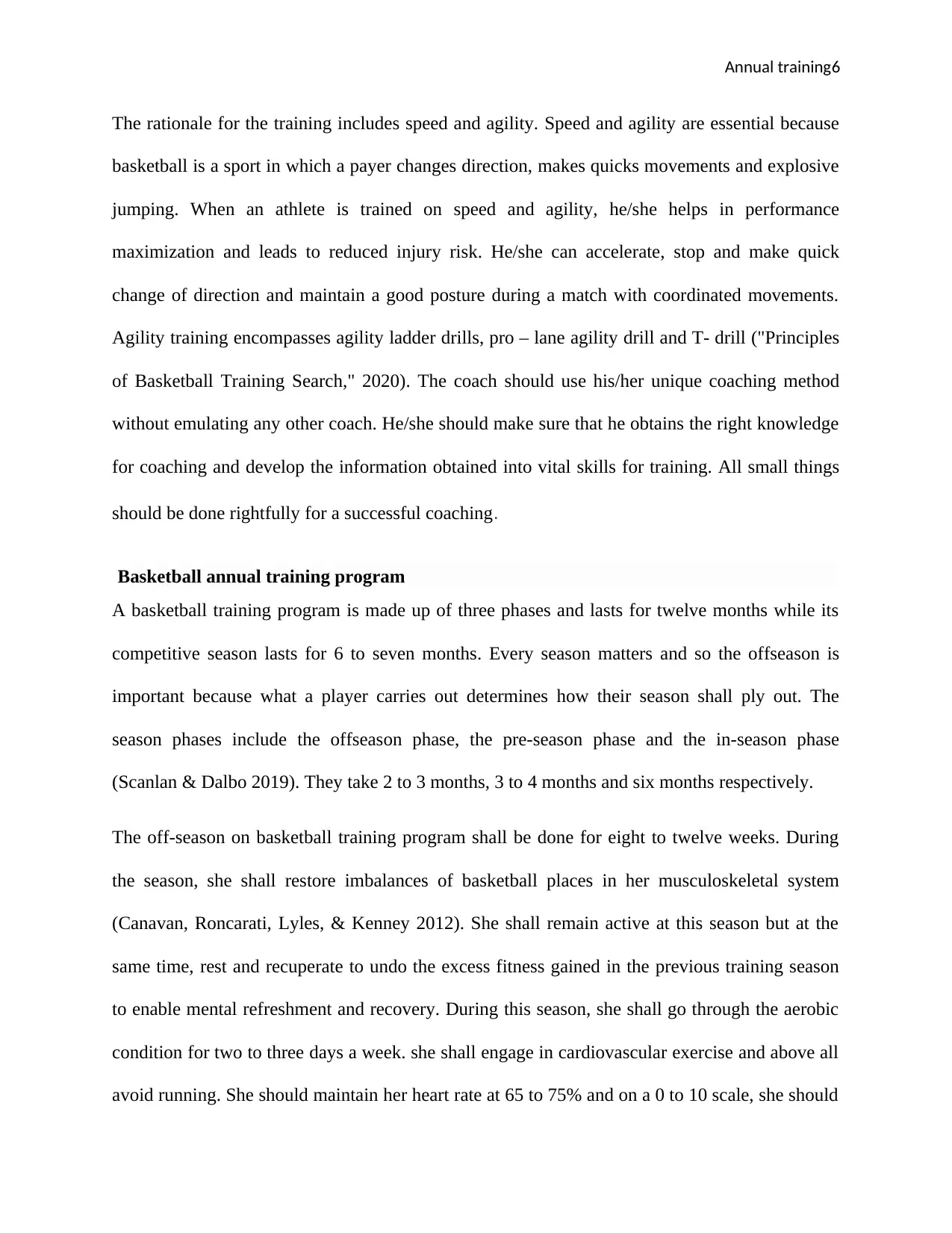
Annual training6
The rationale for the training includes speed and agility. Speed and agility are essential because
basketball is a sport in which a payer changes direction, makes quicks movements and explosive
jumping. When an athlete is trained on speed and agility, he/she helps in performance
maximization and leads to reduced injury risk. He/she can accelerate, stop and make quick
change of direction and maintain a good posture during a match with coordinated movements.
Agility training encompasses agility ladder drills, pro – lane agility drill and T- drill ("Principles
of Basketball Training Search," 2020). The coach should use his/her unique coaching method
without emulating any other coach. He/she should make sure that he obtains the right knowledge
for coaching and develop the information obtained into vital skills for training. All small things
should be done rightfully for a successful coaching.
Basketball annual training program
A basketball training program is made up of three phases and lasts for twelve months while its
competitive season lasts for 6 to seven months. Every season matters and so the offseason is
important because what a player carries out determines how their season shall ply out. The
season phases include the offseason phase, the pre-season phase and the in-season phase
(Scanlan & Dalbo 2019). They take 2 to 3 months, 3 to 4 months and six months respectively.
The off-season on basketball training program shall be done for eight to twelve weeks. During
the season, she shall restore imbalances of basketball places in her musculoskeletal system
(Canavan, Roncarati, Lyles, & Kenney 2012). She shall remain active at this season but at the
same time, rest and recuperate to undo the excess fitness gained in the previous training season
to enable mental refreshment and recovery. During this season, she shall go through the aerobic
condition for two to three days a week. she shall engage in cardiovascular exercise and above all
avoid running. She should maintain her heart rate at 65 to 75% and on a 0 to 10 scale, she should
The rationale for the training includes speed and agility. Speed and agility are essential because
basketball is a sport in which a payer changes direction, makes quicks movements and explosive
jumping. When an athlete is trained on speed and agility, he/she helps in performance
maximization and leads to reduced injury risk. He/she can accelerate, stop and make quick
change of direction and maintain a good posture during a match with coordinated movements.
Agility training encompasses agility ladder drills, pro – lane agility drill and T- drill ("Principles
of Basketball Training Search," 2020). The coach should use his/her unique coaching method
without emulating any other coach. He/she should make sure that he obtains the right knowledge
for coaching and develop the information obtained into vital skills for training. All small things
should be done rightfully for a successful coaching.
Basketball annual training program
A basketball training program is made up of three phases and lasts for twelve months while its
competitive season lasts for 6 to seven months. Every season matters and so the offseason is
important because what a player carries out determines how their season shall ply out. The
season phases include the offseason phase, the pre-season phase and the in-season phase
(Scanlan & Dalbo 2019). They take 2 to 3 months, 3 to 4 months and six months respectively.
The off-season on basketball training program shall be done for eight to twelve weeks. During
the season, she shall restore imbalances of basketball places in her musculoskeletal system
(Canavan, Roncarati, Lyles, & Kenney 2012). She shall remain active at this season but at the
same time, rest and recuperate to undo the excess fitness gained in the previous training season
to enable mental refreshment and recovery. During this season, she shall go through the aerobic
condition for two to three days a week. she shall engage in cardiovascular exercise and above all
avoid running. She should maintain her heart rate at 65 to 75% and on a 0 to 10 scale, she should
⊘ This is a preview!⊘
Do you want full access?
Subscribe today to unlock all pages.

Trusted by 1+ million students worldwide
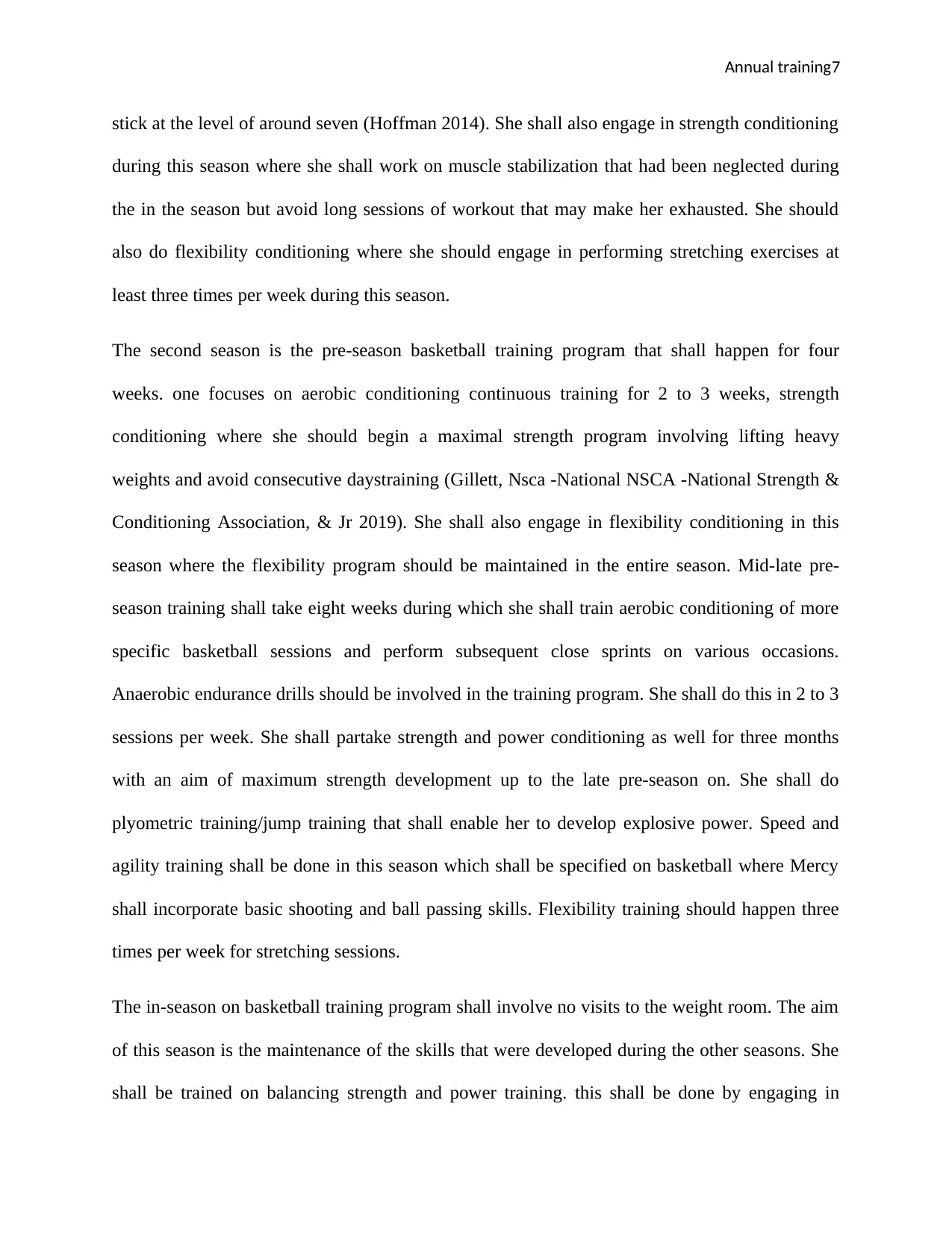
Annual training7
stick at the level of around seven (Hoffman 2014). She shall also engage in strength conditioning
during this season where she shall work on muscle stabilization that had been neglected during
the in the season but avoid long sessions of workout that may make her exhausted. She should
also do flexibility conditioning where she should engage in performing stretching exercises at
least three times per week during this season.
The second season is the pre-season basketball training program that shall happen for four
weeks. one focuses on aerobic conditioning continuous training for 2 to 3 weeks, strength
conditioning where she should begin a maximal strength program involving lifting heavy
weights and avoid consecutive daystraining (Gillett, Nsca -National NSCA -National Strength &
Conditioning Association, & Jr 2019). She shall also engage in flexibility conditioning in this
season where the flexibility program should be maintained in the entire season. Mid-late pre-
season training shall take eight weeks during which she shall train aerobic conditioning of more
specific basketball sessions and perform subsequent close sprints on various occasions.
Anaerobic endurance drills should be involved in the training program. She shall do this in 2 to 3
sessions per week. She shall partake strength and power conditioning as well for three months
with an aim of maximum strength development up to the late pre-season on. She shall do
plyometric training/jump training that shall enable her to develop explosive power. Speed and
agility training shall be done in this season which shall be specified on basketball where Mercy
shall incorporate basic shooting and ball passing skills. Flexibility training should happen three
times per week for stretching sessions.
The in-season on basketball training program shall involve no visits to the weight room. The aim
of this season is the maintenance of the skills that were developed during the other seasons. She
shall be trained on balancing strength and power training. this shall be done by engaging in
stick at the level of around seven (Hoffman 2014). She shall also engage in strength conditioning
during this season where she shall work on muscle stabilization that had been neglected during
the in the season but avoid long sessions of workout that may make her exhausted. She should
also do flexibility conditioning where she should engage in performing stretching exercises at
least three times per week during this season.
The second season is the pre-season basketball training program that shall happen for four
weeks. one focuses on aerobic conditioning continuous training for 2 to 3 weeks, strength
conditioning where she should begin a maximal strength program involving lifting heavy
weights and avoid consecutive daystraining (Gillett, Nsca -National NSCA -National Strength &
Conditioning Association, & Jr 2019). She shall also engage in flexibility conditioning in this
season where the flexibility program should be maintained in the entire season. Mid-late pre-
season training shall take eight weeks during which she shall train aerobic conditioning of more
specific basketball sessions and perform subsequent close sprints on various occasions.
Anaerobic endurance drills should be involved in the training program. She shall do this in 2 to 3
sessions per week. She shall partake strength and power conditioning as well for three months
with an aim of maximum strength development up to the late pre-season on. She shall do
plyometric training/jump training that shall enable her to develop explosive power. Speed and
agility training shall be done in this season which shall be specified on basketball where Mercy
shall incorporate basic shooting and ball passing skills. Flexibility training should happen three
times per week for stretching sessions.
The in-season on basketball training program shall involve no visits to the weight room. The aim
of this season is the maintenance of the skills that were developed during the other seasons. She
shall be trained on balancing strength and power training. this shall be done by engaging in
Paraphrase This Document
Need a fresh take? Get an instant paraphrase of this document with our AI Paraphraser
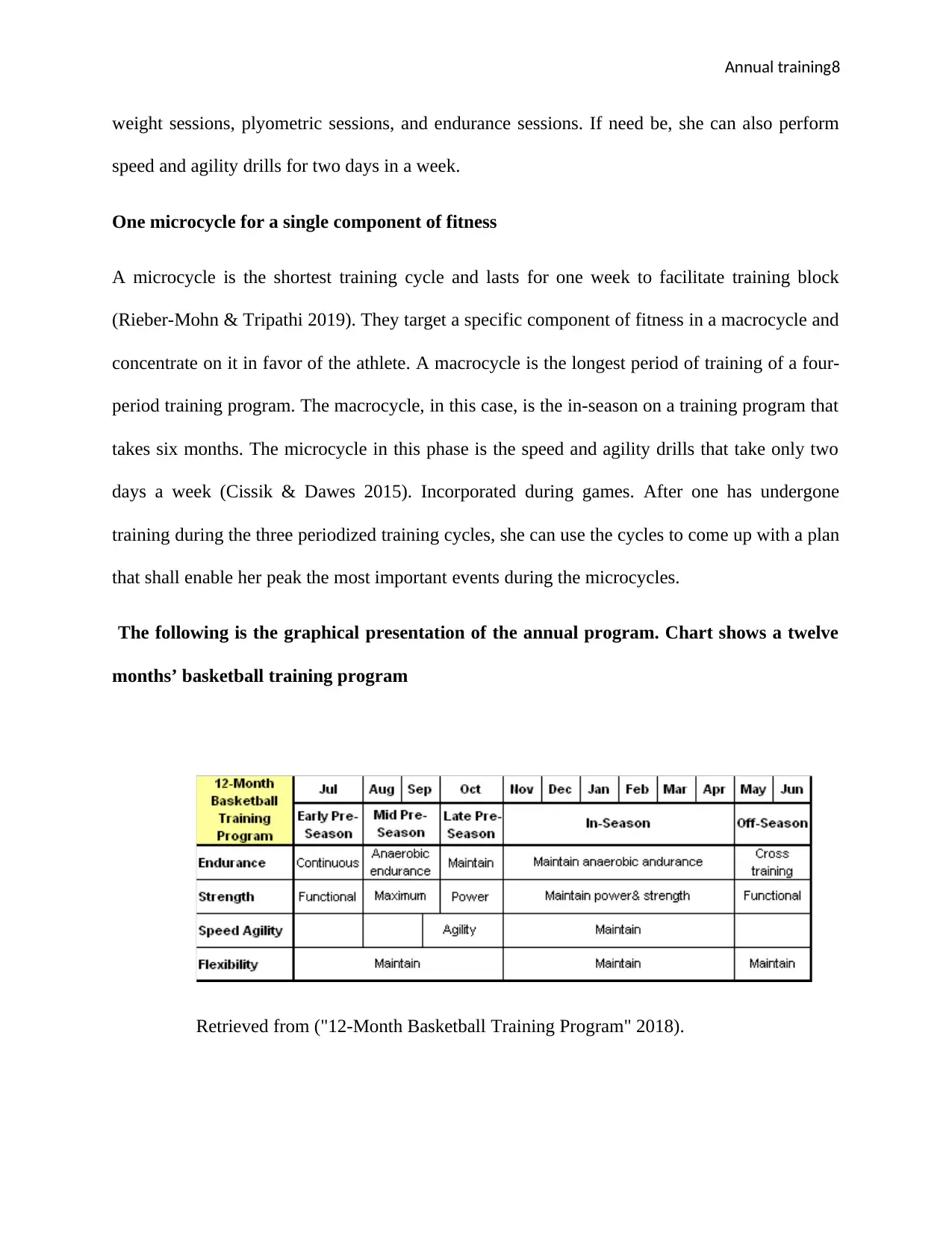
Annual training8
weight sessions, plyometric sessions, and endurance sessions. If need be, she can also perform
speed and agility drills for two days in a week.
One microcycle for a single component of fitness
A microcycle is the shortest training cycle and lasts for one week to facilitate training block
(Rieber-Mohn & Tripathi 2019). They target a specific component of fitness in a macrocycle and
concentrate on it in favor of the athlete. A macrocycle is the longest period of training of a four-
period training program. The macrocycle, in this case, is the in-season on a training program that
takes six months. The microcycle in this phase is the speed and agility drills that take only two
days a week (Cissik & Dawes 2015). Incorporated during games. After one has undergone
training during the three periodized training cycles, she can use the cycles to come up with a plan
that shall enable her peak the most important events during the microcycles.
The following is the graphical presentation of the annual program. Chart shows a twelve
months’ basketball training program
Retrieved from ("12-Month Basketball Training Program" 2018).
weight sessions, plyometric sessions, and endurance sessions. If need be, she can also perform
speed and agility drills for two days in a week.
One microcycle for a single component of fitness
A microcycle is the shortest training cycle and lasts for one week to facilitate training block
(Rieber-Mohn & Tripathi 2019). They target a specific component of fitness in a macrocycle and
concentrate on it in favor of the athlete. A macrocycle is the longest period of training of a four-
period training program. The macrocycle, in this case, is the in-season on a training program that
takes six months. The microcycle in this phase is the speed and agility drills that take only two
days a week (Cissik & Dawes 2015). Incorporated during games. After one has undergone
training during the three periodized training cycles, she can use the cycles to come up with a plan
that shall enable her peak the most important events during the microcycles.
The following is the graphical presentation of the annual program. Chart shows a twelve
months’ basketball training program
Retrieved from ("12-Month Basketball Training Program" 2018).
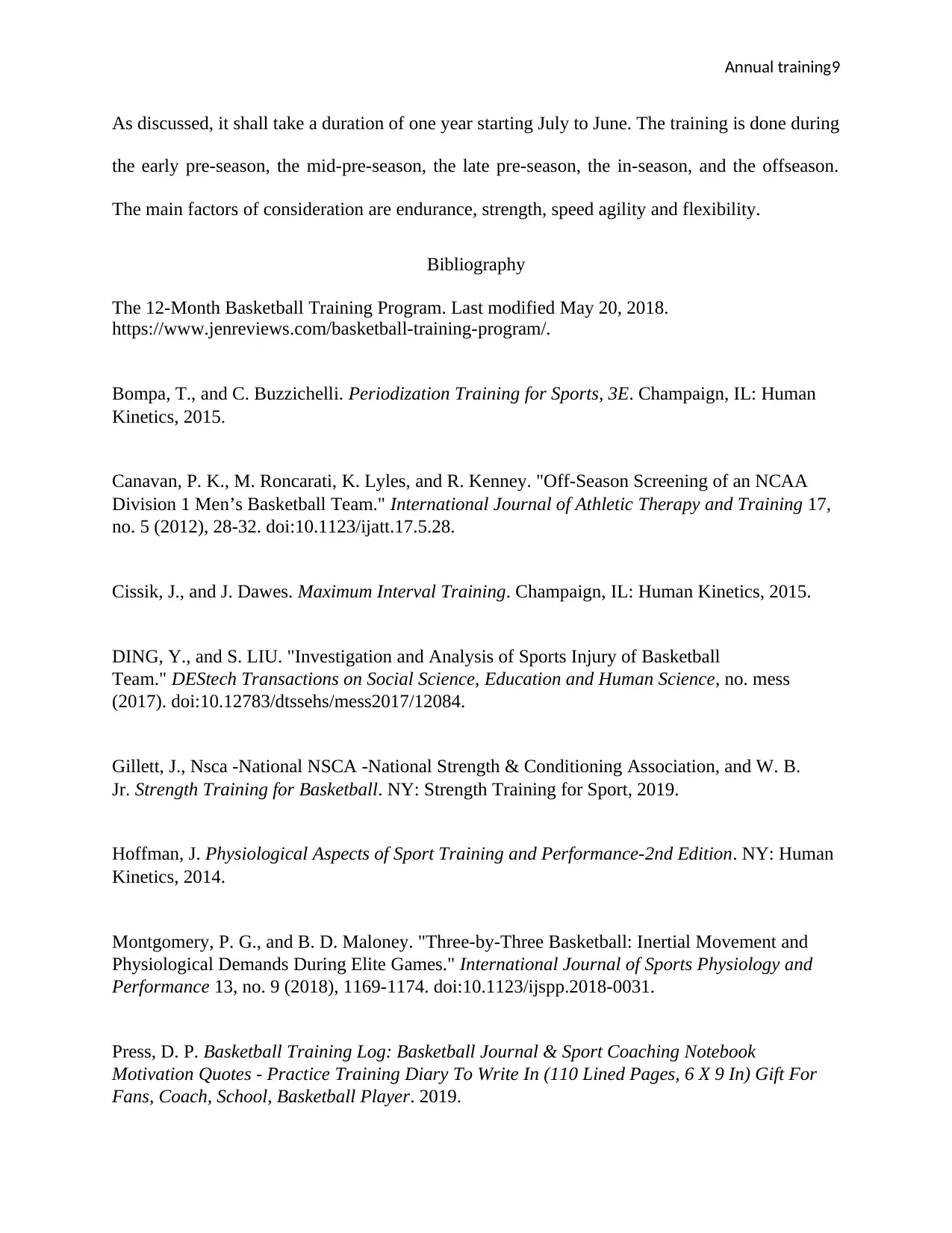
Annual training9
As discussed, it shall take a duration of one year starting July to June. The training is done during
the early pre-season, the mid-pre-season, the late pre-season, the in-season, and the offseason.
The main factors of consideration are endurance, strength, speed agility and flexibility.
Bibliography
The 12-Month Basketball Training Program. Last modified May 20, 2018.
https://www.jenreviews.com/basketball-training-program/.
Bompa, T., and C. Buzzichelli. Periodization Training for Sports, 3E. Champaign, IL: Human
Kinetics, 2015.
Canavan, P. K., M. Roncarati, K. Lyles, and R. Kenney. "Off-Season Screening of an NCAA
Division 1 Men’s Basketball Team." International Journal of Athletic Therapy and Training 17,
no. 5 (2012), 28-32. doi:10.1123/ijatt.17.5.28.
Cissik, J., and J. Dawes. Maximum Interval Training. Champaign, IL: Human Kinetics, 2015.
DING, Y., and S. LIU. "Investigation and Analysis of Sports Injury of Basketball
Team." DEStech Transactions on Social Science, Education and Human Science, no. mess
(2017). doi:10.12783/dtssehs/mess2017/12084.
Gillett, J., Nsca -National NSCA -National Strength & Conditioning Association, and W. B.
Jr. Strength Training for Basketball. NY: Strength Training for Sport, 2019.
Hoffman, J. Physiological Aspects of Sport Training and Performance-2nd Edition. NY: Human
Kinetics, 2014.
Montgomery, P. G., and B. D. Maloney. "Three-by-Three Basketball: Inertial Movement and
Physiological Demands During Elite Games." International Journal of Sports Physiology and
Performance 13, no. 9 (2018), 1169-1174. doi:10.1123/ijspp.2018-0031.
Press, D. P. Basketball Training Log: Basketball Journal & Sport Coaching Notebook
Motivation Quotes - Practice Training Diary To Write In (110 Lined Pages, 6 X 9 In) Gift For
Fans, Coach, School, Basketball Player. 2019.
As discussed, it shall take a duration of one year starting July to June. The training is done during
the early pre-season, the mid-pre-season, the late pre-season, the in-season, and the offseason.
The main factors of consideration are endurance, strength, speed agility and flexibility.
Bibliography
The 12-Month Basketball Training Program. Last modified May 20, 2018.
https://www.jenreviews.com/basketball-training-program/.
Bompa, T., and C. Buzzichelli. Periodization Training for Sports, 3E. Champaign, IL: Human
Kinetics, 2015.
Canavan, P. K., M. Roncarati, K. Lyles, and R. Kenney. "Off-Season Screening of an NCAA
Division 1 Men’s Basketball Team." International Journal of Athletic Therapy and Training 17,
no. 5 (2012), 28-32. doi:10.1123/ijatt.17.5.28.
Cissik, J., and J. Dawes. Maximum Interval Training. Champaign, IL: Human Kinetics, 2015.
DING, Y., and S. LIU. "Investigation and Analysis of Sports Injury of Basketball
Team." DEStech Transactions on Social Science, Education and Human Science, no. mess
(2017). doi:10.12783/dtssehs/mess2017/12084.
Gillett, J., Nsca -National NSCA -National Strength & Conditioning Association, and W. B.
Jr. Strength Training for Basketball. NY: Strength Training for Sport, 2019.
Hoffman, J. Physiological Aspects of Sport Training and Performance-2nd Edition. NY: Human
Kinetics, 2014.
Montgomery, P. G., and B. D. Maloney. "Three-by-Three Basketball: Inertial Movement and
Physiological Demands During Elite Games." International Journal of Sports Physiology and
Performance 13, no. 9 (2018), 1169-1174. doi:10.1123/ijspp.2018-0031.
Press, D. P. Basketball Training Log: Basketball Journal & Sport Coaching Notebook
Motivation Quotes - Practice Training Diary To Write In (110 Lined Pages, 6 X 9 In) Gift For
Fans, Coach, School, Basketball Player. 2019.
⊘ This is a preview!⊘
Do you want full access?
Subscribe today to unlock all pages.

Trusted by 1+ million students worldwide
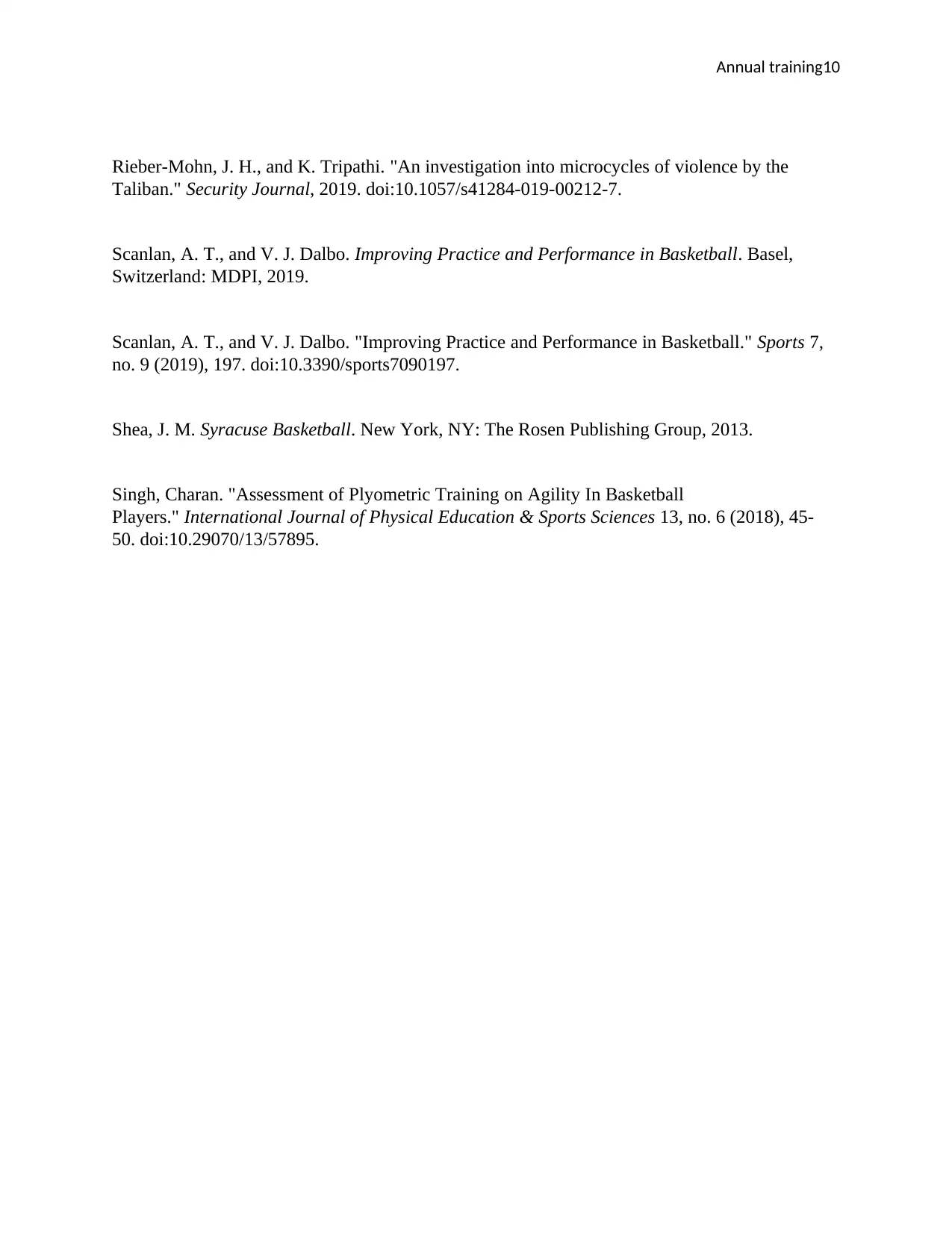
Annual training10
Rieber-Mohn, J. H., and K. Tripathi. "An investigation into microcycles of violence by the
Taliban." Security Journal, 2019. doi:10.1057/s41284-019-00212-7.
Scanlan, A. T., and V. J. Dalbo. Improving Practice and Performance in Basketball. Basel,
Switzerland: MDPI, 2019.
Scanlan, A. T., and V. J. Dalbo. "Improving Practice and Performance in Basketball." Sports 7,
no. 9 (2019), 197. doi:10.3390/sports7090197.
Shea, J. M. Syracuse Basketball. New York, NY: The Rosen Publishing Group, 2013.
Singh, Charan. "Assessment of Plyometric Training on Agility In Basketball
Players." International Journal of Physical Education & Sports Sciences 13, no. 6 (2018), 45-
50. doi:10.29070/13/57895.
Rieber-Mohn, J. H., and K. Tripathi. "An investigation into microcycles of violence by the
Taliban." Security Journal, 2019. doi:10.1057/s41284-019-00212-7.
Scanlan, A. T., and V. J. Dalbo. Improving Practice and Performance in Basketball. Basel,
Switzerland: MDPI, 2019.
Scanlan, A. T., and V. J. Dalbo. "Improving Practice and Performance in Basketball." Sports 7,
no. 9 (2019), 197. doi:10.3390/sports7090197.
Shea, J. M. Syracuse Basketball. New York, NY: The Rosen Publishing Group, 2013.
Singh, Charan. "Assessment of Plyometric Training on Agility In Basketball
Players." International Journal of Physical Education & Sports Sciences 13, no. 6 (2018), 45-
50. doi:10.29070/13/57895.
1 out of 10
Related Documents
Your All-in-One AI-Powered Toolkit for Academic Success.
+13062052269
info@desklib.com
Available 24*7 on WhatsApp / Email
![[object Object]](/_next/static/media/star-bottom.7253800d.svg)
Unlock your academic potential
Copyright © 2020–2025 A2Z Services. All Rights Reserved. Developed and managed by ZUCOL.





